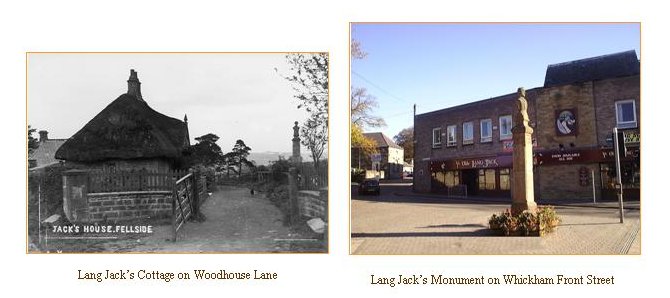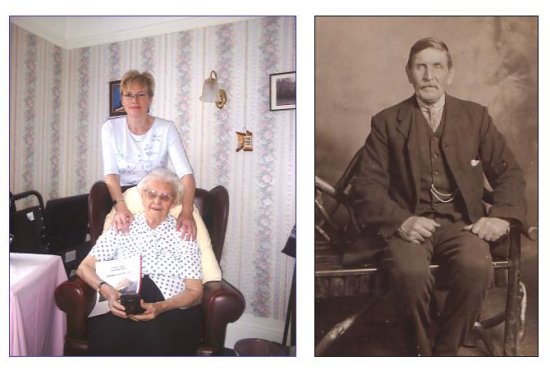 |
 |
The Tyneside Sampson
|
JOHN ENGLISH (THE TYNESIDE SAMSON)CHARACTER OF WHICKHAM
John English is as much a part of
local history as any other subject.
Better known locally as "Lang Jack",
many have heard that famous name, but
few know of the man. He is indeed part
of Northern Folklore, not just
restricted to Whickham.
Born 25th March 1800, thought to be at
Chester le Street, he was a man of
enormous strength, standing six feet
four inches in his stockings. He had a
walking stride of three feet three
inches and was a familiar sight at the
head of political processions. Lang
Jack came to live at Whickham in the
1830’s. He had worked on the Newcastle
Gaol and on St Thomas’ Church at
Barrass Bridge, he had also worked on
the erection of the suspension bridge
at Scotswood which was completed on
16th April 1831. In 1842 he erected
the stone pillars for the bridge over
the Derwent at Winlaton Mill, a stone
on the bridge bore the
inscription, “John English, mason,
anno 1842.” Jack was married to
Eleanor Robinson (1799 – 26th July
1858) and they had thirteen children,
seven boys and six girls. (A branch of
the family tree, drawn up by his great
great grand-daughter Hazel Atkinson,
is
appended).
Jacks political activities would have
been frowned on by the modern day
Trade Unions. In October 1831 a county
demonstration was held at Durham, at
which Mr. Charles James Clavering, of
Axwell Park presided. Crowley’s
workmen accompanied Mr. Charles
Attwood from Whickham, a political
reformist, to the meeting. A rumour
prevailed that the workmen at the pits
of the Marquis of Londonderry
agitating against the introduction of
the Reform Bill, would attend and
attempt to break up the meeting, but
Crowley’s crew with Lang Jack as their
leader, had armed themselves
with “peel-grains” or oak-saplings
from Gibside wood and waited around
the platform for any hostile feeling
that might be displayed by the pitmen.
True enough, the pitmen began to
manifest their disapproval of the
utterances of one of the speakers.
When Attwood called for Crowley’s crew
to preserve order, immediately
the “peel grains” were wielded so
effectively, that the pitmen fled in
disorder and the meeting proceeded
without further interruption.
Afterwards Crowley’s men were regaled
with bread, cheese and ale.
Jack wasn't the type of person you
would invite home for a drink, he was
reputed to have an alcohol problem,
his 'party piece' was quite unusual.
He would jump up and down on the spot
each time getting higher and higher,
until his head bumped the ceiling. It
is known, that whilst performing
his 'party piece' at one house, the
floor couldn't take his weight and
collapsed underneath him. He ended up
in a cowshed under the house luckily
unhurt.
|
 |

He was also reputed to be ill-tempered, a cart filled with stones knocked over his dog and killed it. According to a friend, Jack was so annoyed that he took hold of the cart by the wheel and tipped it complete with horse, down a bankside. Jack built a cottage at the end of Woodhouse Lane near Fellside Road Whickham. He dragged the stones for his cottage from a quarry a mile away, the chimney pots alone weighed 12 stones.
In acknowledgement of his fame, an eighteen feet high monument, sculpted in 1854 stood near his cottage. The figure of Jack was considered to be an excellent one. It was designed and executed by John Norvel, of Swalwell. The monument was erected by public subscription early in 1860. Jack was a kindly man and had been very popular, crowds of people collected to see the monument unveiled. After the ceremony, a parade headed by the Whickham Brass Band, marched to the Three Tuns Inn at Whickham, where speeches were made amidst great enthusiasm. Unfortunately Jack attempted to do things for which even his marvellous strength was unequal and destroyed his once splendid constitution. He died on 22nd August 1860 of consumption, on his death the cottage he built became the property of the Claverings of Axwell.
One day in 1907 at three-o-clock one cold Sunday morning, the cottage was destroyed by a fire. The last family to live there were named Morris, they fled from the fire in their night clothes and escaped unhurt. The monument, which stood next to it became vandalized, local children would throw stones at it, and there was a fear that it may even be pushed over causing death or injury. Thankfully, in 1976 Bellway builder moved and restored it to it’s present position in the village of Whickham near "The Crown Inn", a fitting memorial to an extraordinary character. In 1999 the Crown Inn closed for renovation and expansion work. In June 1999 it reopened with the new name, “Ye Olde Lang Jack”. The photograph shows the pub and the monument.
|
 |
There are a few photographs in existence of Lang Jack’s cottage, these are probably the oldest and it is tempting to think that the tall gentleman on the left hand photograph may be Jack. Although this type of photograph may not have been possible prior to his death in 1860. Close inspection reveals a lady and a small child behind the wall.
It is probable that the photograph on the right, is dated c1905, remembering that the cottage was destroyed by fire in 1907. The identity of the men remains a mystery.
|
 |

Lang Jack’s House
(Destroyed By Fire in 1907)
There’s an old rustic cottage that was built on a Fell
and in that a family named Morris did dwell.
But now it’s in ruins which was caused by a fire
and this family retreated in their night attire.
About three-o-clock on a cold Sunday morn,
this old thatched cottage of it’s roof was shorn,
and old bare walls, they now remain
of the house that Jack built in the sandy lane.
Now this cottage was built by a man large and tall,
little thinking that ever his cottage would fall.
In a fire, a mystery that no one can deny
so to replace, let’s all have a try.
Now Jack was a giant of rare skill and tract,
who ne’er finished his work until it was compact.
He finished the monument and likewise the house,
yet Jack was as humble as any church mouse.
Let us do our best to provide them a home,
for no body knows what trouble may come.
To a man and his family and also his wife,
in our troubles and trials on our journey through life.
Now Jack English a working man who toiled might and main,
to build that quaint cottage in an old sandy lane.
But now it’s gone and departed from view,
the least thing we ask, is sympathy from you.
Written By W.Tingle
The Morris Family
John Morris aged 58 years, his wife Sarah Ann Morris aged 55 years and their son Walter Edwin aged 15 years old lived in Lang Jacks cottage in 1907. John & Sarah Ann had four sons and one daughter, they were, John James born 1867, Herbert Ernest born 1871, Mary Verena born 1875, Arthur William and Walter Edwin born 1885. With the exception of Walter the children had left the cottage.
The grandson of John and Sarah Ann, John Morris born 29th December 1900 lived with his parents Arthur William Morris and his wife on Napier Road Swalwell, but was staying with his grandparents at the cottage on the night of the fire in 1907. When the blaze took hold during the night, 7 years old John was pushed through a window to safety along with some items including paintings. Along with their few possessions the family were taken up to ‘The Woodman’s Arms a public house on Fellside Road. The story of the fire has been passed down over the generations of the Morris family, apparently a drunken lodger at the cottage knocked over an oil lamp which started the devastating fire. (At the time of the fire an artist Davey Hood was lodging with the Morris family, it is possible that he was the person who caused the fire).
It was thanks to the discovery of a poem that we first learned of the Morris family, the poem was written by W. Tingle on 25th February 1907 and published to sell and raise money to help the destitute family.
The story of the family was provided by the granddaughter of John Morris, Maureen.
|
 |
Prior to the Bellway building near the site of Lang Jack’s Cottage in the mid 1970’s. The local farmer of that time Mr Davidson, who was a patient of Whickham’s Dr David Smith, suggested that the stone gateposts at the entrance to the burned out remains of the cottage door, may be suitable for Dr Smith’s garden. These are the original posts and probably all that remains of the cottage and its surrounds.
The gateposts were photographed and the painting of Lang Jack’s Cottage by local artist G.E.Turnbull reproduced, by kind permission of the owner Mrs Gillian Smith
|
 |

It was thanks to Mrs Marjorie (Madge) Wainwright and her daughter Ena Gallon a member of our History Society, that the story of Lang Jack was resurrected with much more information forthcoming. Madge produced a container thought to be a trinket box, it was given to her grandfather Jack Ismay from Lang Jack’s cottage and is believed to be the sole survivor of Lang Jack’s property. Mr Ismay was a friend and workmate of Lang Jack, he passed the box on to his son Robert who in turn passed it on to his daughter Marjorie. The box is donated to Whickham Library where it is now on permanent display. It was as a result of a newspaper article on Madge’s story, that Mr Derrick Bell contacted us regarding a painting his father Thomas Bell had done, depicting Lang Jack on Clockburn Lonnen displaying his legendary strength and bad temper, the painting is now on permanent display in Whickham Library. It was also thanks to the newspaper report, that Hazel Atkinson the great great grand-daughter of Lang Jack contacted us and provided a wealth of information. Including her branch of Lang Jack's family tree and the death certicates of Jack and his wife Eleanor.
Pictured above on the left, Mrs Madge Wainwright and her daughter Ena Gallon, on the right Jack Ismay, Madge's grandfather a friend and workmate of Lang Jack,
|
 |
Lang Jack was reputed to have an alcohol problem, he regularly over indulged. However he did not die of an alcohol related disease, he died on 22nd August 1860 of consumption, a pulmonary disease prevelant in those days. It was Jack's wife Eleanor who died on 26th July 1858 of cirrhosis of the liver, an alcohol related disease.
|
 |
It is possibly unkind to assume, that due to the nature of the disease which ended her life, Eleanor was an alcoholic. It is something which will remain a mystery.
|
 |
|
|
|
 |